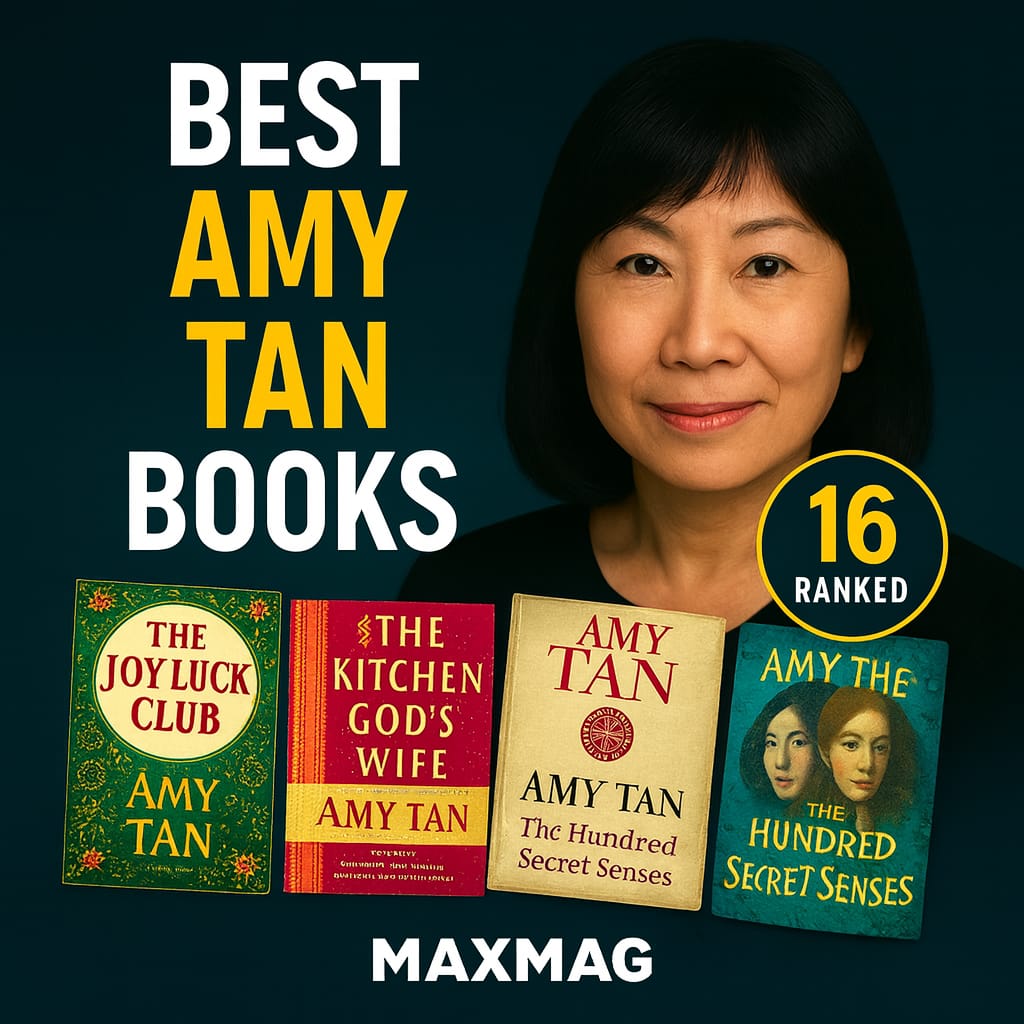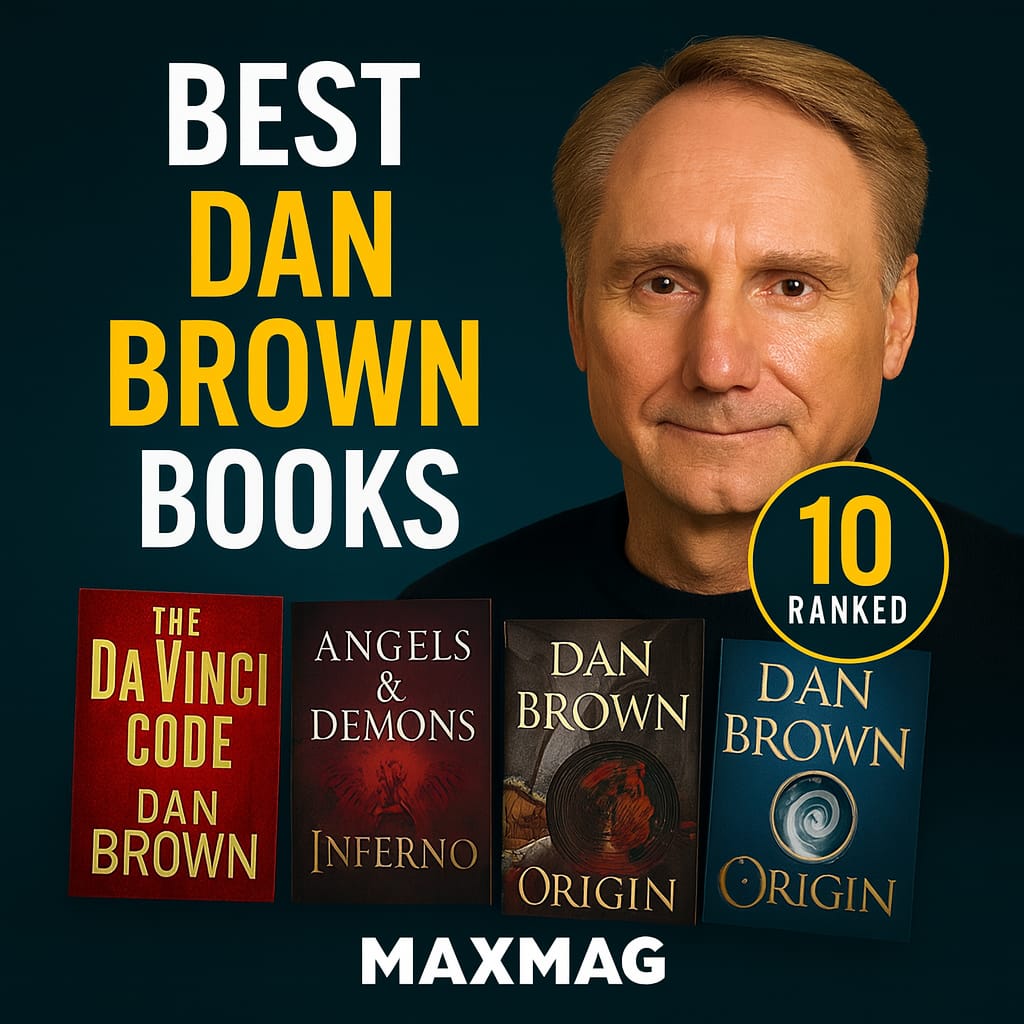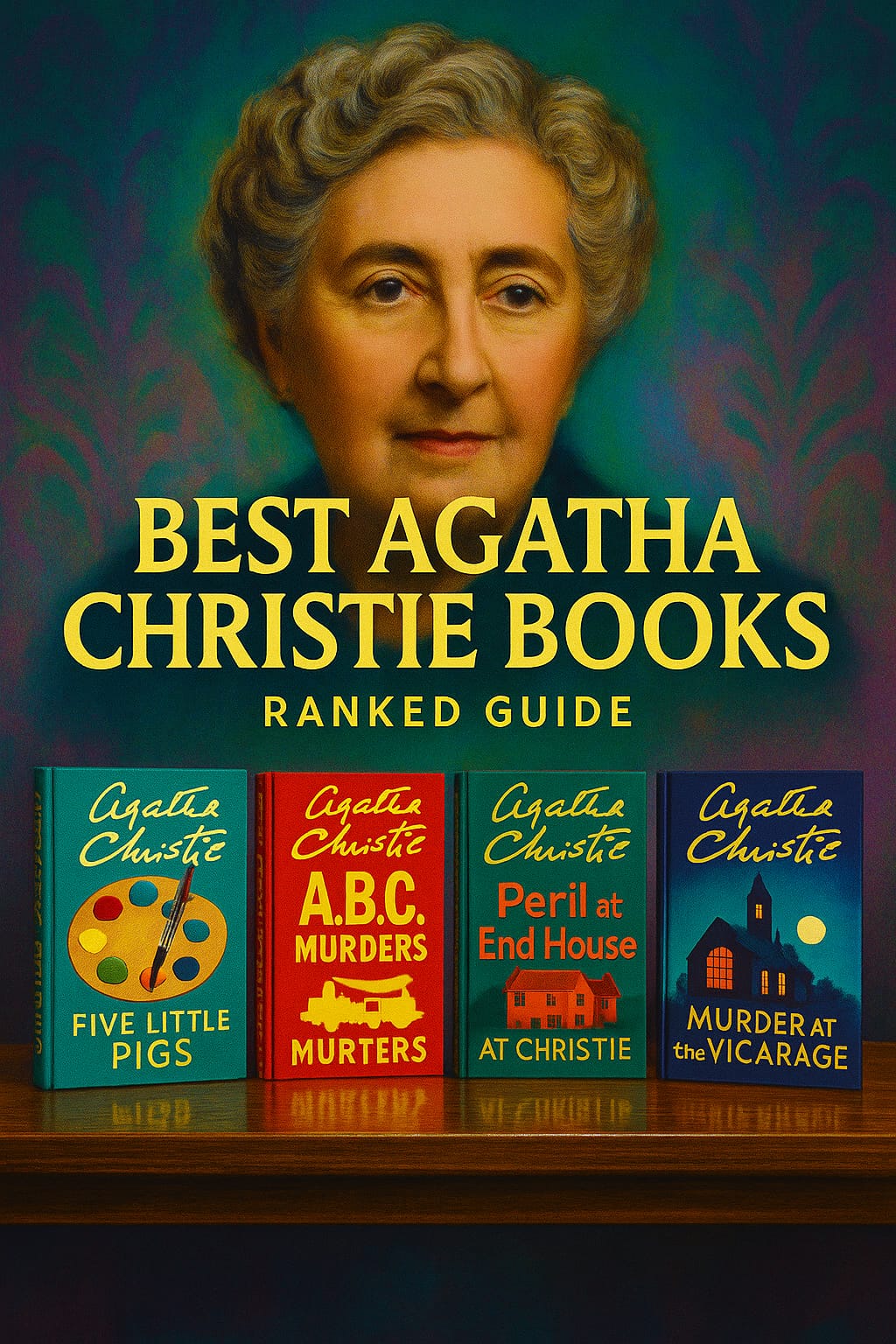
Across a century of puzzles and publishing, the Best Agatha Christie Books remain touchstones. Agatha Mary Clarissa Christie, from Torquay, England, wrote crime and mystery fiction, plays, and short stories. She is widely known for Hercule Poirot and Miss Marple. Signature titles include “Murder on the Orient Express” and “And Then There Were None.” Her career stretched from 1920 through the 1970s with astonishing consistency. The output formed the backbone of modern detective storytelling.
Her breakout arrived with “The Mysterious Affair at Styles,” introducing Poirot and setting an enduring template. Her best‑selling title is “And Then There Were None,” a singular phenomenon in crime fiction. Recurring motifs include poison expertise, false identities, clockwork motives, and moral ambiguity. Readers return for compact puzzles, credible motives, and human-scale stakes. This ranked guide to the Best Agatha Christie Books includes 21 titles. It is sequenced in rising rating order; ties by year, then title.
21 Best Agatha Christie Books in a Rising Rating Order
Methodology & Updates
This ranking of the Best Agatha Christie Books uses public Goodreads averages captured on October 17, 2025; eligibility required ≥3.0/5. Ties were broken by earlier publication year, then A–Z title. Reader re‑ratings may shift future positions, and we periodically refresh datasets to reflect those changes. This ranking focuses on long‑form works and major collections.
#1) The Big Four – 1927
- Author: Agatha Christie
- Published: 1927
- Work Type / Genre Tags: novel, detective fiction, Hercule Poirot
- Themes: conspiracy, identity, global reach
- Goodreads Rating: 3.57/5
In London and across Europe, Hercule Poirot and Captain Hastings confront whispers of a shadowy cabal. A sudden death linked to cryptic clues exposes a coordinated conspiracy with global ambitions. Poirot’s immediate objective is to identify the four principals directing the hidden network. He relies on Hastings and Inspector Japp as alliances strain under decoys and double agents. Kidnappings, coded messages, and staged accidents complicate each lead and force rapid pivots. The stakes rise as the group’s reach threatens witnesses, investigators, and international stability. Poirot maneuvers toward a trap that will separate the mastermind from the organization without naming the final gambit. The case narrows to a decisive confrontation whose outcome determines whether the syndicate endures or collapses.
#2) Hallowe’en Party – 1969
- Author: Agatha Christie
- Published: 1969
- Work Type / Genre Tags: novel, detective fiction, Hercule Poirot
- Themes: memory, rumor, small-town secrets
- Goodreads Rating: 3.57/5
In an English village during a festive party, a child boasts of witnessing a murder and is later found dead. The revelation turns a playful gathering into the start of a calculated killing spree. Poirot’s objective is to link past events to the present crime and protect the remaining guests. He coordinates with Ariadne Oliver as memories, gossip, and old resentments surface. Dormant scandals, mistaken identities, and a missing piece of evidence reshape the suspect pool. Threats escalate when another attack suggests a murderer determined to erase history. Poirot charts a path to a reveal that hinges on who could recreate a specific circumstance and why. The final sequence aligns timelines and alibis to demonstrate how a childhood claim triggered deadly consequences.
#3) The Body in the Library – 1942
- Author: Agatha Christie
- Published: 1942
- Work Type / Genre Tags: novel, detective fiction, Miss Marple
- Themes: appearances, class, village life
- Goodreads Rating: 3.82/5
At an estate in St. Mary Mead, a stranger’s corpse appears in the Bantrys’ library before dawn. The discovery jolts a quiet village and demands immediate answers for how the victim arrived. Miss Marple aims to map social ties that connect the house to a seaside resort. She observes household habits and community whispers that expose rivalries and hidden meetings. Conflicting testimonies, altered clothes, and a second body complicate the trail. Pressure builds as timelines refuse to align and alibis depend on routine chores. Marple tracks a pattern of opportunity that points toward staged appearances and deliberate misdirection. A closing confrontation reconstructs movements to show who exploited familiarity with the setting.
#4) Dead Man’s Folly – 1956
- Author: Agatha Christie
- Published: 1956
- Work Type / Genre Tags: novel, detective fiction, Hercule Poirot
- Themes: games, deception, jealousy
- Goodreads Rating: 3.82/5
At a country-house fete, a staged “Murder Hunt” conceals an actual killing on the grounds. What begins as entertainment becomes a cover for a carefully timed crime. Poirot’s goal is to decode the game’s design to reveal the real target. He weighs the hostess’s anxieties, family tensions, and guests’ shifting stories. Switched roles, misleading costumes, and a disappeared participant complicate the design. The threat grows as the event’s map disguises routes that only insiders understand. Poirot steers toward a reveal that rests on who could navigate the property under a precise schedule. The resolution traces the mock clues back to a genuine motive anchored in longstanding grievance.
#5) The Secret Adversary – 1922
- Author: Agatha Christie
- Published: 1922
- Work Type / Genre Tags: novel, espionage-adventure, Tommy & Tuppence
- Themes: postwar intrigue, partnership, nationhood
- Goodreads Rating: 3.84/5
In postwar London, Tommy and Tuppence form a partnership and stumble into a missing‑person mystery. A chance job leads them toward a hidden file and a rumor of political blackmail. Their objective is simple: stay alive long enough to unmask the figure known as the ‘Adversary.’ Allies and decoys appear as the pair learn to read signals in coded notes and sudden betrayals. Impersonations, safe houses, and a shipboard trail complicate their pursuit. The stakes rise when a kidnapped witness becomes leverage against both of them. A final ploy lures the mastermind into revealing operational habits without telegraphing the sting. The end restores a stolen identity and closes a dossier that had threatened national stability.
#6) The Pale Horse – 1961
- Author: Agatha Christie
- Published: 1961
- Work Type / Genre Tags: novel, detective fiction, standalone
- Themes: poison, rumor, moral panic
- Goodreads Rating: 3.84/5
After a dying woman’s confession, a list of names surfaces alongside rumors of deaths that look like illness. A witness traces the pattern to a village and an inn with occult whispers. The investigator’s task is to separate superstition from a practical method of murder. Acquaintances, lovers, and a few professional contacts form a web that conceals the delivery of poison. False alibis, mislabelled remedies, and a staged séance complicate the inquiry. Risk deepens when the method appears undetectable and the next target is already chosen. A controlled test edges toward a climax built on who had access and how orders were transmitted. The case closes on a mechanism that weaponizes trust and ordinary routines.
#7) The Moving Finger – 1942
- Author: Agatha Christie
- Published: 1942
- Work Type / Genre Tags: novel, detective fiction, Miss Marple
- Themes: gossip, reputation, community
- Goodreads Rating: 3.85/5
In Lymstock, anonymous letters inflame suspicion until a death pushes gossip into violence. A community feud becomes the frame for a targeted campaign. Miss Marple’s allies focus on how the letters travel and whose knowledge they exploit. Neighbors, servants, and visitors reveal tensions that predate the first note. Forged hands, staged scenes, and a misread timetable complicate every inference. The danger intensifies when a second attack suggests the writer needs chaos to hide a separate crime. Marple guides a line toward a reveal that depends on recognizing a practiced observer’s vantage. The final turn fixes authorship and motive in a pattern of control masked as scandal.
#8) Death in the Clouds – 1935
- Author: Agatha Christie
- Published: 1935
- Work Type / Genre Tags: novel, detective fiction, Hercule Poirot
- Themes: claustrophobia, observation, misdirection
- Goodreads Rating: 3.86/5
Mid‑flight from Paris to Croydon, a passenger dies among strangers seated inches apart. A cabin packed with witnesses becomes the impossible setting of the murder. Poirot’s objective is to prove a killing occurred and reconstruct how a weapon moved unseen. He examines seating, luggage, and fleeting glances as relationships emerge after landing. Clerks, hairdressers, and collectors provide fragments that lead in conflicting directions. Threats mount as the killer anticipates searches and uses ordinary items to erase traces. The approach to the climax turns on a sleight‑of‑hand only viable under precise conditions. The aftermath aligns seating plans and opportunity to show a murder planned for a specific altitude.
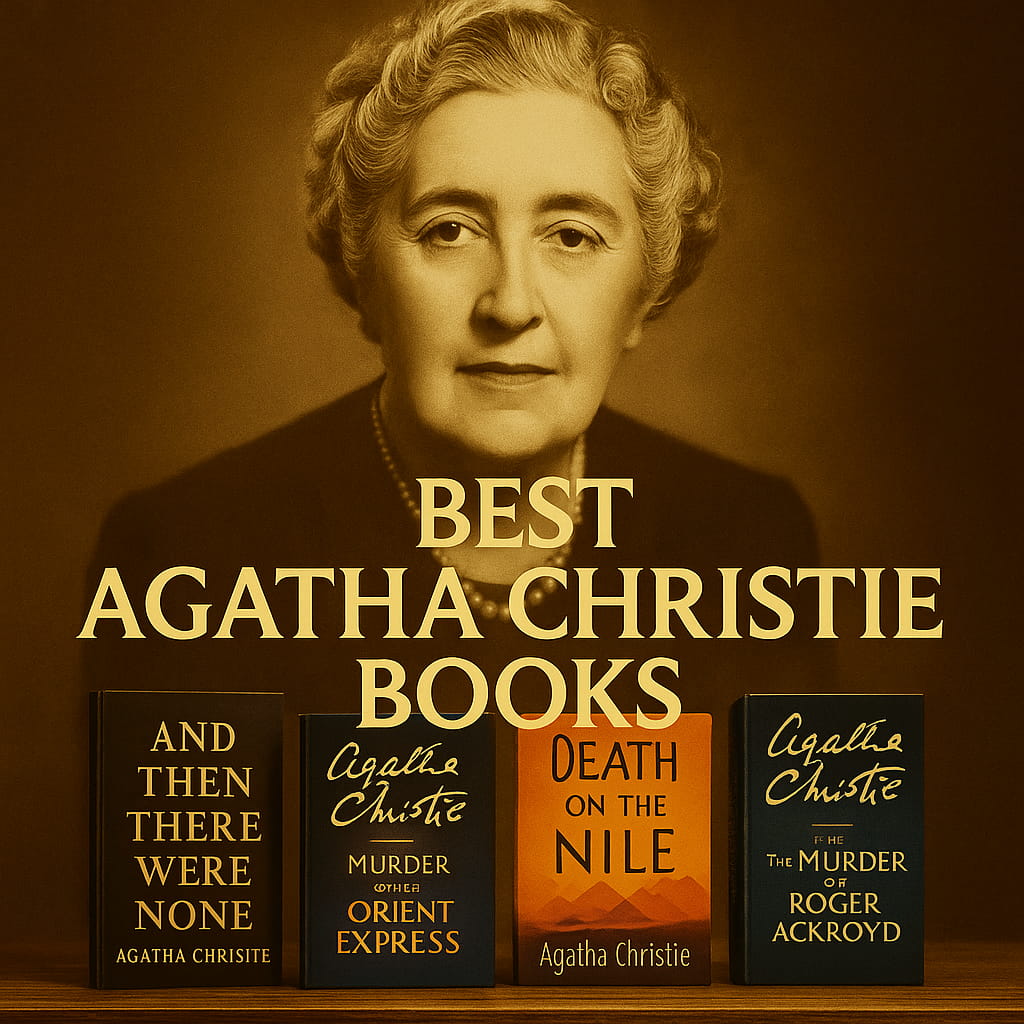
Early Currents in the Best Agatha Christie Books
#9) The Murder on the Links – 1923
- Author: Agatha Christie
- Published: 1923
- Work Type / Genre Tags: novel, detective fiction, Hercule Poirot
- Themes: love, inheritance, duplicity
- Goodreads Rating: 3.87/5
In a French seaside town, Poirot arrives too late to save a client who feared an attack. A second corpse and a buried past redraw the map of motives. Poirot’s goal is to untangle rival claims of love, money, and revenge. Hastings’s romantic entanglement and local police rivalries complicate cooperation. Disguises, a vanished woman, and swapped identities send the case in circles. Pressure builds when alibis depend on trains, telegrams, and a staged abduction. Poirot steers toward a reveal that hinges on who controlled access to a key document. The resolution connects a long‑ago crime to a present plot executed on familiar ground.
#10) Poirot Investigates – 1924
- Author: Agatha Christie
- Published: 1924
- Work Type / Genre Tags: short story collection, detective fiction, Hercule Poirot
- Themes: logic, pattern, criminal variety
- Goodreads Rating: 3.89/5
Across linked cases, Poirot and Hastings confront thefts, disappearances, and murders in miniature. Each new client arrives with an enigma that resists a single method. Poirot’s objective is to apply order and inference to disparate puzzles. He balances Hastings’s instincts against patterns buried in trivial details. Unexpected weapons, double bluffs, and misheard words complicate seemingly simple facts. The stakes rise as copycats and opportunists try to exploit the confusion. Poirot moves case by case toward reveals shaped by psychology and timing. Endings reassemble small clues to show how ordinary oversights enable crime.
Later-Middle Turns in the Best Agatha Christie Books
#11) The Mysterious Affair at Styles – 1920
- Author: Agatha Christie
- Published: 1920
- Work Type / Genre Tags: novel, detective fiction, Hercule Poirot
- Themes: war displacement, poison, order vs. chaos
- Goodreads Rating: 4.00/5
During wartime recovery in Essex, an heiress dies after a sudden collapse at a country house. Signs of poison create a closed circle of suspects bound by money and resentment. Poirot’s immediate objective is to test each alibi against the chemistry of dosage and delay. He watches Hastings and the family for slips that expose private arrangements. Conflicting wills, medicine bottles, and overheard quarrels make the path uncertain. Tension mounts as a wrongful arrest threatens to lock in the wrong outcome. Poirot’s trajectory heads toward a demonstration focused on opportunity and access. The final accounting traces a substitution that turned ordinary treatment into a lethal plan.
#12) Peril at End House – 1932
- Author: Agatha Christie
- Published: 1932
- Work Type / Genre Tags: novel, detective fiction, Hercule Poirot
- Themes: identity, survival, staged danger
- Goodreads Rating: 4.02/5
On a Cornish headland, Poirot meets a young woman who has survived a string of near‑fatal accidents. A fresh attempt convinces him someone close is staging her death. His objective is to protect her while discovering who gains if she dies. Friends, admirers, and visiting relatives feed a circle of competing versions. Forged notes, switched identities, and a manipulated will complicate the field. Danger escalates when a misdirected attack shows the killer will risk spectacle. Poirot advances toward a reveal that depends on the visibility of a signature accessory. The finish sets out how proximity and patience allowed the plot to mature in plain sight.
#13) The A.B.C. Murders – 1936
- Author: Agatha Christie
- Published: 1936
- Work Type / Genre Tags: novel, detective fiction, Hercule Poirot
- Themes: serial method, profiling, misdirection
- Goodreads Rating: 4.03/5
Anonymous letters warn Poirot of murders scheduled by place and alphabet. Public fear grows as killings appear to obey a grim pattern. Poirot’s task is to read the performance itself and look past the obvious sequence. He works with Hastings and police while grieving families expose ordinary routines. A salesman’s travels, rivalries, and planted evidence complicate the picture. The stakes rise as the killer taunts investigators with punctuality and spectacle. Poirot shapes a climax that turns on a private obsession masked by a public game. The end reframes the pattern as camouflage for a single, personal motive.
#14) Five Little Pigs – 1942
- Author: Agatha Christie
- Published: 1942
- Work Type / Genre Tags: novel, detective fiction, Hercule Poirot
- Themes: memory, testimony, time
- Goodreads Rating: 4.03/5
Poirot reopens a 16‑year‑old poisoning at a country house upon a daughter’s request. No new crime occurs; only five accounts must be weighed against the past. His objective is to extract truth from memory and reconstruct the day’s timetable. Former lovers, friends, and rivals describe the same hours with different emphases. Missing sketches, misread glances, and a child’s vantage complicate recollection. Stakes grow as each witness must confront what was seen and what was assumed. The path to the climax aligns fixed facts with a detail only one person could know. Poirot’s conclusion identifies how memory preserved the key while hiding its meaning.
#15) Murder at the Vicarage – 1930
- Author: Agatha Christie
- Published: 1930
- Work Type / Genre Tags: novel, detective fiction, Miss Marple
- Themes: village networks, respectability, motive
- Goodreads Rating: 4.04/5
In St. Mary Mead, a disliked magistrate is shot inside the vicar’s study. Confessions arrive too quickly and do not fit the physical facts. Miss Marple’s objective is to decode routines—garden paths, appointments, and gossip—into timelines. She observes couples, churchgoers, and a newcomer whose habits unsettle expectations. Mislaid notes, a misfiring clock, and a staged distraction complicate the inquiry. Risk grows as the wrong suspect seems destined to take the blame. Marple’s path to the climax maps who could move unseen between adjoining rooms. The outcome aligns village rhythms with a single calculated window for the shot.
#16) Crooked House – 1949
- Author: Agatha Christie
- Published: 1949
- Work Type / Genre Tags: novel, detective fiction, standalone
- Themes: family dynamics, inheritance, corruption
- Goodreads Rating: 4.08/5
After a patriarch’s sudden death, a sprawling family gathers under suspicion in a suburban mansion. An inheritance dispute becomes the frame for new dangers. The narrator’s objective is to understand a household where affection and resentment mix. Siblings, spouses, and children trade accusations as secrets emerge from years of dependence. Misread wills, altered medicines, and competing guardians complicate the search. The threat intensifies when a witness to the past is targeted. The trajectory of the climax points to a culprit shaped by the house’s warped loyalties. The closing consequence forces the family to face what its structure created.
Momentum Builds Across the Best Agatha Christie Books
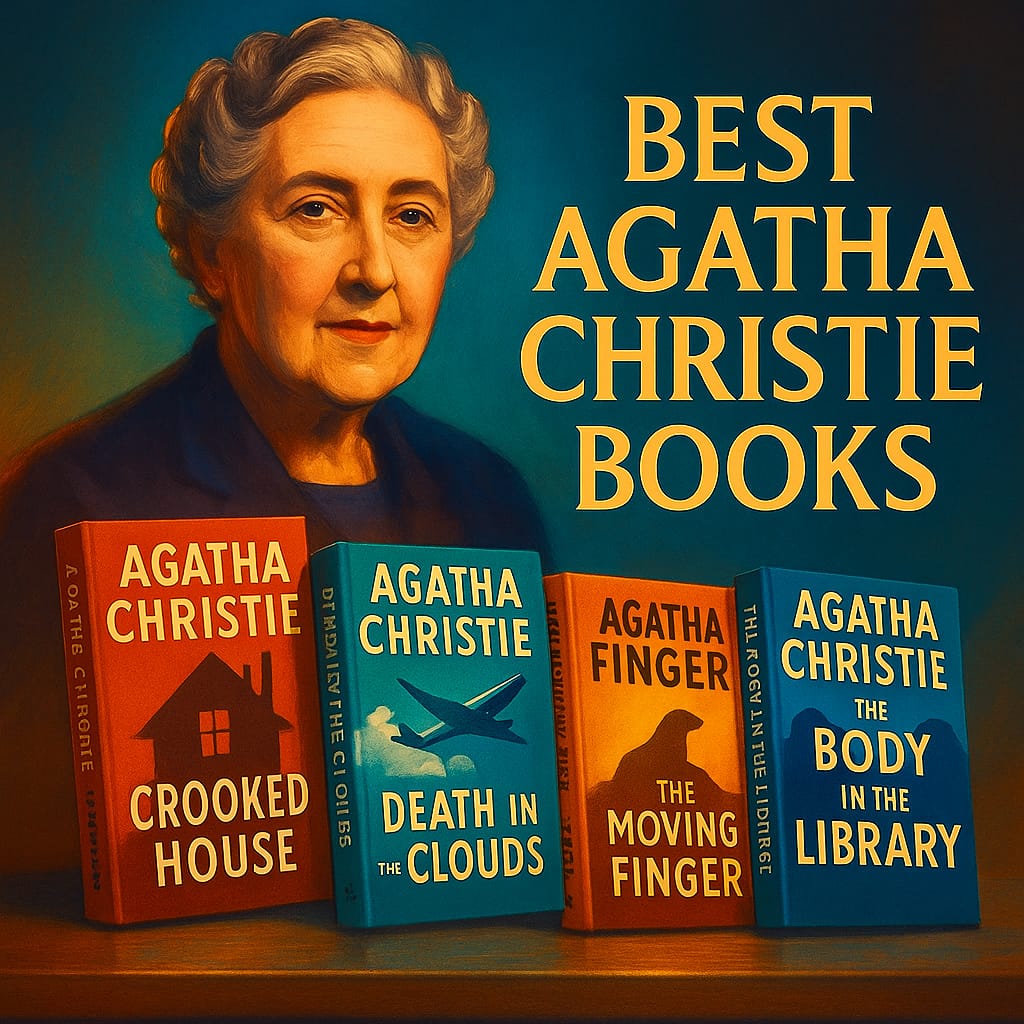
#17) Curtain: Poirot’s Last Case – 1975
- Author: Agatha Christie
- Published: 1975
- Work Type / Genre Tags: novel, detective fiction, Hercule Poirot
- Themes: fate, manipulation, endings
- Goodreads Rating: 4.10/5
Back at Styles, the site of his first case, Poirot seeks to stop a killer who never touches a weapon. A series of tragedies suggests manipulation rather than direct action. Poirot’s objective is to expose the instigator’s method before another death occurs. Old friends, suspicious guests, and past scandals create a dense field of motive. Cryptic notes, planted frictions, and staged encounters complicate the pattern. Stakes escalate as the suspect’s influence seems to remove all safe options. Poirot prepares a final maneuver that risks his health to close the circle. The aftermath fixes responsibility while preserving the precise mechanism from immediate view.
#18) Death on the Nile – 1937
- Author: Agatha Christie
- Published: 1937
- Work Type / Genre Tags: novel, detective fiction, Hercule Poirot
- Themes: jealousy, wealth, enclosure
- Goodreads Rating: 4.12/5
A luxury cruise on the Nile gathers wealthy travelers with entangled histories. A honeymoon feud becomes the prelude to a shooting that shatters the voyage. Poirot’s objective is to map cabins, alibis, and movements along the decks. He interrogates companions, staff, and bystanders whose loyalties blur. Missing firearms, forged notes, and timed distractions complicate the picture. Peril mounts when the murderer strikes again to defend the first attack. Poirot steers toward a climax that hinges on coordinated timing and a staged absence. The final arrangement shows how jealousy and planning reshaped a public holiday into a crime scene.
#19) Murder on the Orient Express – 1934
- Author: Agatha Christie
- Published: 1934
- Work Type / Genre Tags: novel, detective fiction, Hercule Poirot
- Themes: justice, complicity, moral codes
- Goodreads Rating: 4.20/5
Snow stops the Orient Express in the Balkans, trapping passengers in a sealed carriage. An American traveler is found dead in his compartment with puzzling clues. Poirot’s aim is to separate planted evidence from genuine traces. He interviews diplomats, servants, and tourists linked by chance itineraries. Contradictory testimonies, multilingual slips, and a burnt note complicate the case. Tension rises as the train remains stranded and the killer rests among the group. The route to the climax weighs strict legality against a broader idea of justice. The ending outlines a decision whose consequences extend beyond the carriage.
#20) The Murder of Roger Ackroyd – 1926
- Author: Agatha Christie
- Published: 1926
- Work Type / Genre Tags: novel, detective fiction, Hercule Poirot
- Themes: unreliability, secrecy, village life
- Goodreads Rating: 4.26/5
In a quiet village, a wealthy patron is stabbed after a scandal erupts around a neighbor’s death. The local doctor narrates an inquiry that unsettles the community. Poirot’s objective is to test confidences and domestic routines for hidden leverage. Family members, servants, and business associates reveal ordinary motives for extraordinary acts. Secret debts, intercepted letters, and a missing weapon complicate every theory. Pressure increases as gossip converts likelihoods into certainties. Poirot advances toward a climax built on who controlled the narrative all along. The final turn shows how a confidently told story can hide the crucial act.
#21) And Then There Were None – 1939
- Author: Agatha Christie
- Published: 1939
- Work Type / Genre Tags: novel, mystery, standalone
- Themes: guilt, isolation, retribution
- Goodreads Rating: 4.27/5
Ten strangers arrive on a Devon island, each summoned by a different pretext. A recorded voice accuses them of past crimes, and the first death follows. The group’s objective narrows to survival as suspicion devours trust. Alliances form and fracture while the house and shoreline offer no escape. Disappearing items, a nursery rhyme, and locked‑room constraints complicate every theory. Stakes escalate with each disappearance as panic replaces reason. The trajectory heads toward an explanation that fits the sequence yet hides its hand. Only a postscript reconstructs how the plan used isolation to deliver judgment.
The Crest of the Best Agatha Christie Books
Agatha Christie: Life & Legacy
Agatha Mary Clarissa Christie (1890–1976) was a British novelist and playwright whose crime fiction, short stories, and stage works reshaped the puzzle mystery. She introduced Hercule Poirot in 1920 and Miss Marple soon after, and wrote across five decades while raising a global readership. Major works include “The Murder of Roger Ackroyd,” “Murder on the Orient Express,” “Death on the Nile,” “Five Little Pigs,” and “And Then There Were None.” Her range—spanning village intrigues to international plots—made the Best Agatha Christie Books a durable reference for readers and educators. Christie’s practical knowledge of poisons from wartime pharmacy service sharpened many methods on the page. Honors included a DBE (1971), and her play “The Mousetrap” set longevity records in London. Translations and adaptations spread the Best Agatha Christie Books across media, sustaining classroom study and popular enthusiasm. Later writers and screen storytellers adapted her misdirection and fair‑play clueing, while the Best Agatha Christie Books continue to shape anthology series and film cycles.
Conclusion
This guide gathers 21 titles, stretching from 1920 to 1975, and shows an arc from early experiments to canonical peaks. At a glance, the ranking traces first outings, village intricacies, and mature moral puzzles across the Best Agatha Christie Books. For an accessible historical lens on Christie’s career and working life, see the Library of Congress overview on her letters and legacy (Library of Congress blog).
Recurring structures across the Best Agatha Christie Books include closed circles, timetable logic, and social masks that crack under pressure, yet settings and stakes vary widely. For cultural context on her methods and recurring use of poison, a concise primer is available via a major U.S. news magazine (TIME on Christie and poison).
FAQ: What to know about the Best Agatha Christie Books
Q1: How did Christie’s first novel establish her approach?
Q2: Which recurring detectives appear in this ranking?
Q3: Why are some fan favorites placed lower?
Q4: What themes recur across these mysteries?
Q5: Where should new readers begin?


